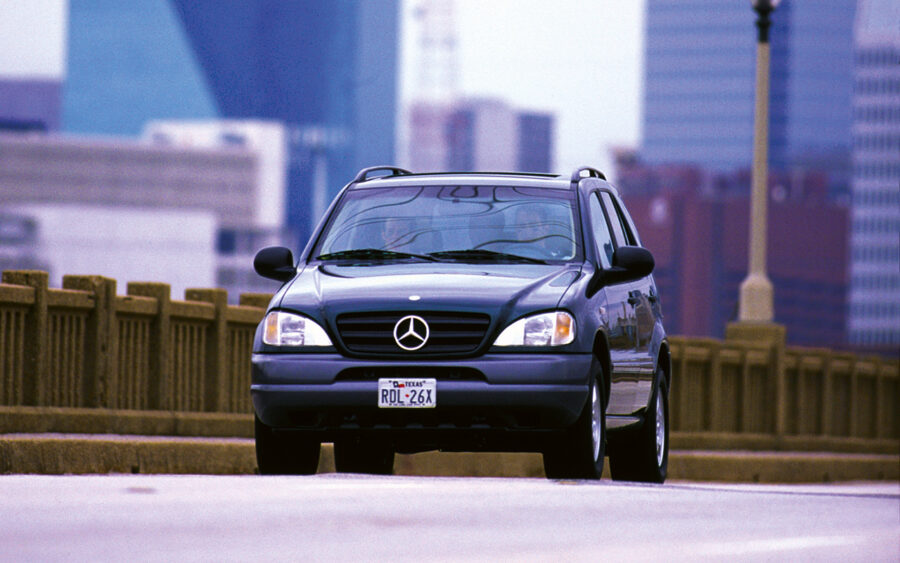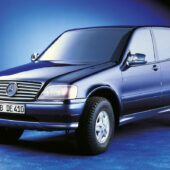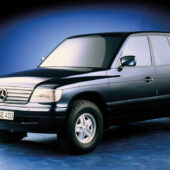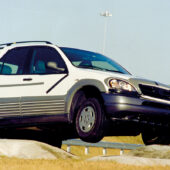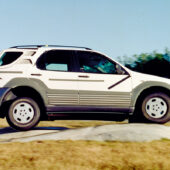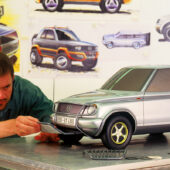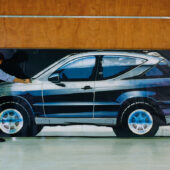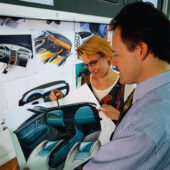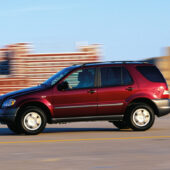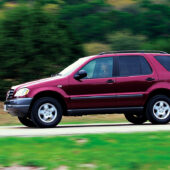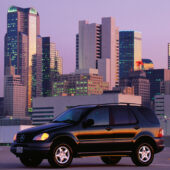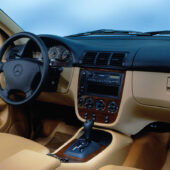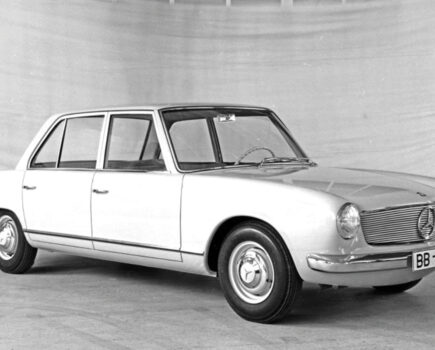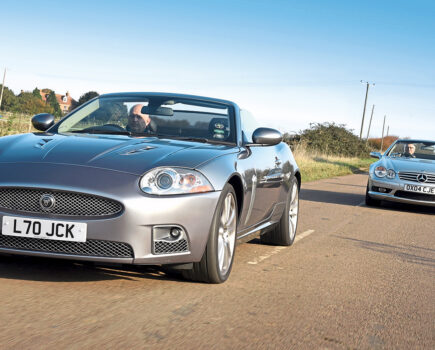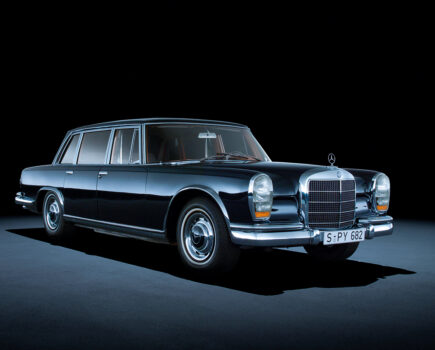A hugely important model for Mercedes, the M-Class set the tone for the brand’s niche-filling focus in the 90s and 2000s
Words: Sam Skelton Images: Mercedes-Benz
Two decades ago, Mercedes launched the first generation M-Class. Traditionalists may have found it’s soft, bulky lines hard to stomach, but nobody could deny that it was an important car for the brand – the first SUV to bear the three pointed star.
The G-Wagen may have been in production since 1979, but it was always a utilitarian vehicle, even after Mercedes attempted to civilize it. Mercedes had to make a totally different product, especially if it was to continue to be a strong force in the all important US market.
By the early 1990s, SUV sales in the United States were booming. In 1990, they accounted for almost 7% of all US car sales, representing 929,000 units and rising to a mammoth 1,750,000 in 1995. Mercedes were already looking to broaden its appeal beyond a conservative core market, and the USA was its biggest customer outside of Germany, so it could ill afford to ignore the SUV segment any longer. In 1992, work commenced to design a true Mercedes SUV. But how was such a car going to look?
Mercedes considered different design proposals from studios in Japan, California and Germany. Subsequent designs varied wildly, ranging from a slightly softened G-Wagen look, to the more “fun” two door proposal that came out of California, which Mercedes was quick to kill off, owing to low consumer interest.
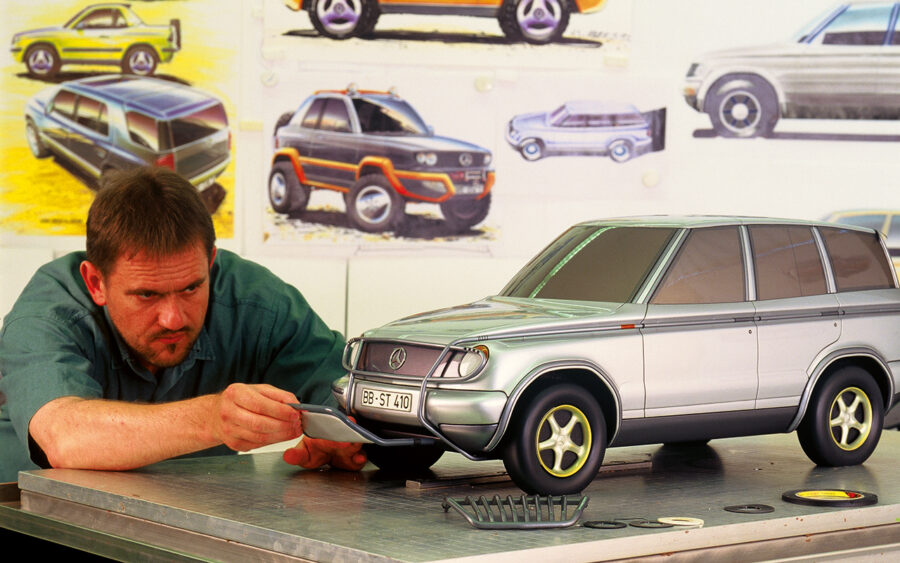
An early design for the M-Class featuring round headlights that didn’t make the cut
Eventually, it was a German proposal that was given the green light by Bruno Sacco, Mercedes-Benz’s Chief of Design. Sacco felt that it was the only proposal that combined the then current Mercedes design language with the visual toughness associated with an off-road vehicle.
Meanwhile, California’s efforts were not to be wasted. They were tasked with developing a concept car to preview the production M-Class at the 1996 Detroit Auto Show, to be known as the All-Activity Vehicle, or AAV.
Styling the M-Class was far from the hardest challenge to project posed: Merced had to construct a completely new factory to build its SUV in. Its existing production facilities were already running at capacity, so from the start it was known that a dedicated M-Class factory would have to be built.
Mercedes anticipated that around 50% of all W163 sales would be made in the US, so the choice to make it in the USA was never really up for debate.
Mercedes considered 30 states, all of which were keen to attract the German car building giant to their town. Far from being viewed as an invader, Mercedes brought with it the promise of up to 1,500 jobs, as well as being seen as a major source of pride for whichever state could home the new factory.
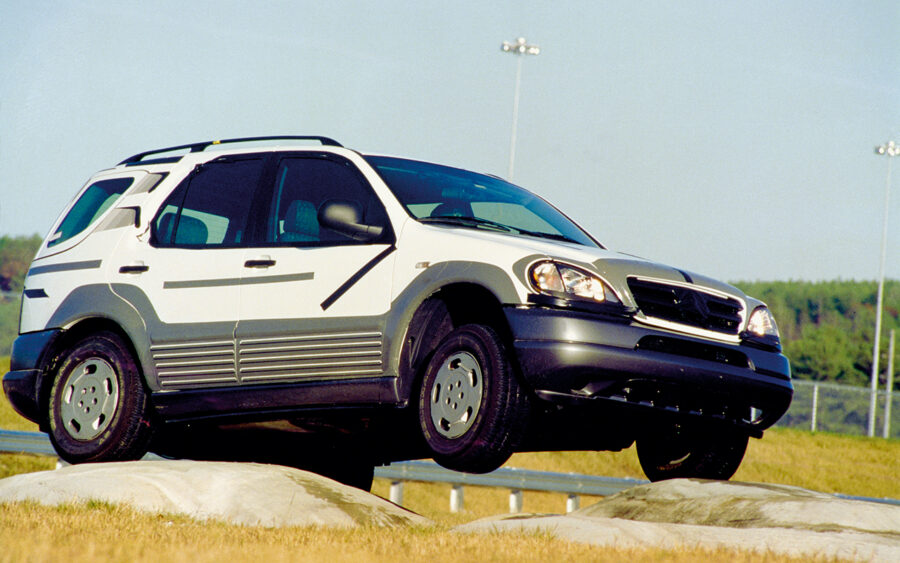
A pre-production prototype undergoing testing
Alabama emerged victorious, owing to a variety of positive factors: the site would be located in the town of Vance, Tuscaloosa, which boasted excellent links to sea and airports. Alabama also homed a willing and able workforce, and a community hungry for the project. Sweetening the deal, Alabama’s state government would donate Mercedes a plot to build to factory on.
Many of new factory’s staff moved in before it was finished, working out of caravans on the construction site. Among them, was new recruit, Thomas Struthwolf. An enthusiast of SUVs, off-road driving, and an admirer of the three pointed star, Struthwolf joined Mercedes’s Tuscaloosa team as Marketing Coordinator.
He recalled an atmosphere of “nervous excitement” in the months and weeks leading up to the M-Class’s debut. “It wasn’t a kind of ‘oh my God, I can’t believe we’re doing this, we shouldn’t be doing this’ kind of nervousness, it was more of a ‘I can’t believe we’re finally making this happen!’ kind of nervousness.” recalled Struthwolf. “There was no top-down management during the project. Everybody was doing what they had to do to make it a success. It was an amazing thing to be part of.”
Struthwolf was part of a new status quo for Mercedes. The W163 project was not only a break away from the traditional Mercedes passenger car, it was a break away from the traditional way of designing a Mercedes.

Previously the Mercedes design process would be akin to a relay race: one team would do their share of the work, before handing the project over to the next one.
For the M-Class, the design process was executed with different departments such as engineering, finance and styling all working in synergy. This would lead the way for all future cars. Mercedes had also been worried about not getting its first SUV right, and future-proofed itself while designing the new car. The decision was made to use a “body on frame” construction method. Completed monocoque body shells, engineered to take 70% of operating stress were lowered onto chassis rails, which accommodated the suspension and steering gear. This construction method may have seemed odd, or even old fashioned, but it would allow Mercedes to be more flexible if they needed to make changes to the car in the future.
The manufacturing process itself would differ at the Tuscaloosa plant too, and the site was effectively used as a working test-bed to trial new ways of building Mercedes passenger cars, such as the “just in time” production method. Outscoring the production of more complex and intricate parts such as seats and dashboard assemblies to trusted suppliers was also a new step. These parts were delivered to Tuscaloosa and installed as one complete piece – in some cases the process was complete less than three hours after the supplier was given the order.
In 1997 America received the first production cars, with Europe and the the UK later getting them in the Autumn. Critical reception in the UK was, at times, lukewarm. While most journalists found its on-road performance good, it did get some criticism for its build quality, with early cars being blasted by the likes of Jeremy Clarkson for their nasty plastics and large panel gaps. Contemporary journalists may have found these points easier to forgive had Mercedes’s pricing been less ambitious. Prices started at £32,000 and could easily run over £40,000 if you got tick-happy with the option boxes.

Initially your choice was limited to just the ML320. Using the 3.2 variant of Mercedes’s new M112 family of V6 engines, some pundits criticised it for not being smooth enough.
But more variety was on the way. A 4.3 V8 M-Class debuted the following year, wearing the ML430 moniker, as well as the Europe-only V6 diesel ML270 CDI and the miserly inline four ML230. Only available as a manual, the entry level car produced an anemic 150bhp which had to shift close to two tons.
Partially vindicating the W163 was its off-road capability. The press couldn’t resist taking it off road, pitching it against established rivals such as the Land Rover Discovery and Jeep Grand Cherokee. Given that it was never meant to be a hard-core mud plugger, it coped well on off road tests, going everywhere that the Jeeps and Land Rovers could.
Driven on an off-road course at Tuscaloosa, which he designed, Struthwolf felt that the W163 out-performed many domestic SUVs.

Some contemporary road testers in the States clearly felt the same way as Struthwolf, with Motor Trend magazine crowning it “Truck of The Year” in 1998, praising it its ability to stay composed on any terrain.
Mercedes had confidence in the W163‘s four wheel drive capability, and owners of the M-Class were encouraged to take it off-road, and Mercedes offered owners optional off-road driving courses.
These courses were more than just a marketing gimmick, explained Sturthwolf: “Saftey was a big part of the M-Class’s appeal, and we didn’t want people to go off road in it without knowing what they were doing, and getting into trouble. We wanted them to do it properly.”
In general, America was far happier with the M-Class than the UK ever was, and Struthwolf couldn’t recall getting any complaints from US consumers about the car’s build quality. On a personal level, he was very fond of it, describing himself as being “in love” with it.

While the M-Class may have won fans in its first year of production, Mercedes themselves later acknowledged that the W163’s build quality wasn’t beyond improvement, and invested $600,000,000 in the still young in American plant to further increase build standards, coinciding with a mid-life facelift in 2001.
The most obvious changes were on the outside, with clear light lenses, fresh alloy wheel designs and new bumper moldings – but perhaps the most important changes were on the inside. Mercedes’s mission to improve the W163’s quality were evident in a better trimmed interior, which benefitted from soft touch plastic on various touch points inside the car, such as the glove box lid and door trims.
Buyers of facelifted cars enjoyed redesigned seats, which were more comfortable, offered more adjustment, as well as being available with a memory function for the first time. Some changes were not visible – but did show how committed Mercedes were improving its SUV. The inner floor pan was thicker, designed to cut out road noise. The doors now had a secondary sill to combat not only road noise, but wind noise, too.
At this stage Mercedes were probably pleased that it made the W163‘s chassis easy to adapt: the front body mounts were reenforced to improve it’s already good crash worthiness, and a new, improved gearbox was offered. M-Class drivers could now manually flick between gears using the automatic gear leaver, thanks to Mercedes’s TouchShift function.
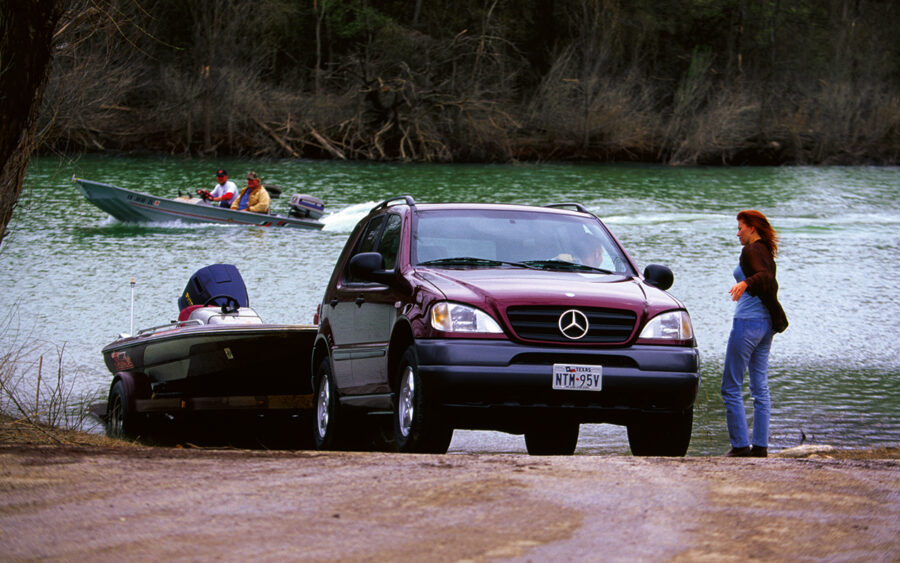
The real news was the introduction of the AMG-tuned ML55. Probably the W163‘s finest hour, these hotrod 4x4s beat Porsche and BMW to the draw with a true high performance SUV. The W163 could stay in production until 2005, until it was replaced by the W164.
Nobody can deny that the W163 is a controversial car – but it is an extremely important one in Mercedes’s history. When it launched the M-Class, what it was really doing was embarking on a massive project to exploit every market niche. It’s only twenty years on that Mercedes have conceded that it may have finally found every niche that there is to fill.
Without the M-Class and the niche-busting vehicles that followed it, the brand may not be in the strong position it is today. The W163’s time in the doldrums may not be over yet, but it was vital for the brand’s long term growth and survival.

